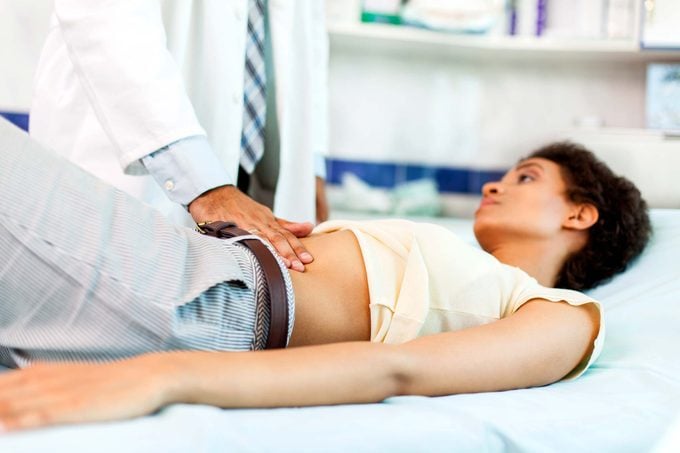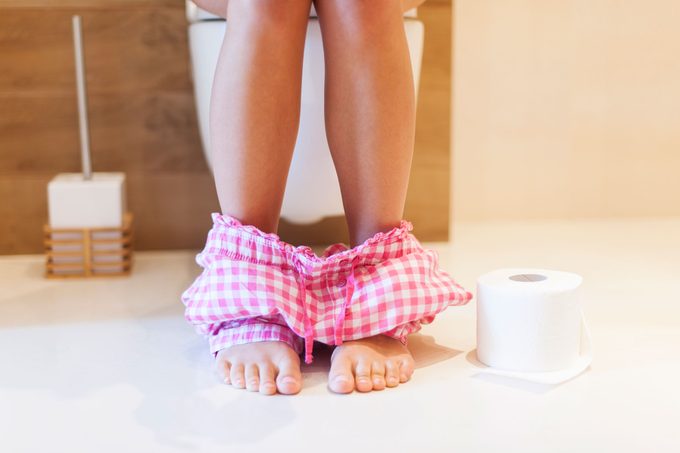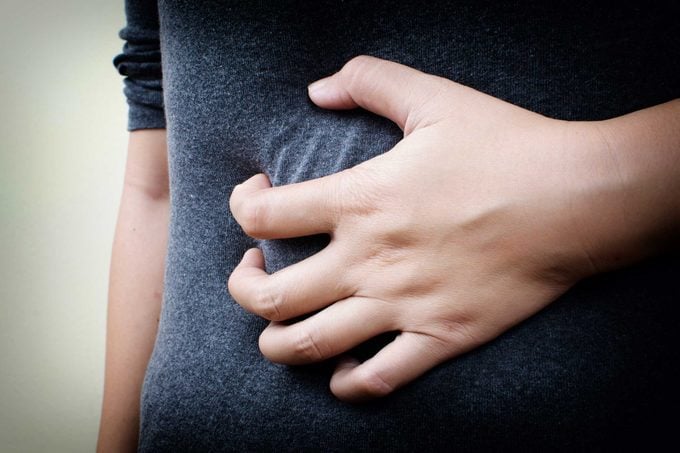6 Warning Signs of Kidney Stones—and What You Can Do to Prevent Them
Updated: Jul. 22, 2022
Stomach aches are no fun, but when the pain becomes excruciating and you're struggling and unable to find a comfortable position sitting or lying down, you might be dealing with more than the occasional upset stomach.

Christopher Coogan, MD, professor of urology at Rush University Medical Center in Chicago, says about 10 to 15 percent of the population will develop kidney stones in their lifetimes, small hard mineral deposits formed in the kidney that can be painful to pass, with white men ages 40 to 60 the most likely to have kidney stones. Those who already have had a kidney stone have a 50 percent chance of developing another within 10 years. But how do you know if what you have is a kidney stone opposed to stomach or back pain? (This is why kidney stones are so painful.)
Sudden and severe pain
Adults are often diagnosed with kidney stones after a trip to the emergency room or visit to their primary physician because of sudden severe abdominal and/or back pain they’ve been experiencing. This sudden and severe pain in the stomach and/or one side of the back is one of the classic symptoms of kidney stones.
“Pain associated with kidney stones often comes on suddenly and is sometimes described as excruciating as the pain associated with labor,” says Douglas Propp, MD, Medical Director and Chair of Emergency Medicine at Advocate Lutheran General Hospital in Park Ridge, Illinois.
Severe pain from which you can find no relief helps differentiate pain associated with kidney stones from a stomach ache or back strain. Pain associated with kidney stones can sometimes be confused with a backache because pain associated with kidney stones can start higher up in the back. As the stone moves closer to the bladder, the location of the pain can move lower. An important difference though: The back pain that accompanies kidney stones is unlike the pain of typical back strains because it is not associated with any movement.
“One can usually figure out which side the kidney stone is on because the pain will typically, although not always, be on one side of the stomach versus the other,” says Dr. Coogan.
Kidney stones can range in size; Dr. Coogan notes the average size of a kidney stone is 5 millimeters. However, the size of the stone doesn’t necessarily affect how much pain someone is in. Even a very tiny kidney stone can cause a “whole lot of hurt,” says Dr. Coogan. Kidney stones can be so painful that they awaken people from sleep and prevent them from finding a standing, sitting, or lying down position that provides relief. (Having kidney stones could be a sign that you’re eating too much protein. Here are other signs that you’re eating too much protein.)
“The pain can come on at any time and is severe, typically preventing the individual from finding a comfortable position, says Dr. Propp.

Blood in the urine
Another possible warning sign of kidney stones is finding blood in one’s urine. Dr. Coogan says this occurs in the majority of patients who have kidney stones. Blood in the urine is an abnormal condition and you should get evaluated if you notice this symptom. (This is what your pee reveals about your health.)
Other warning signs
While sudden and severe stomach and/or back pain and blood in the urine can be key indicators of kidney stones, Dr. Propp and Dr. Coogan noted other warning signs that patients should look for:
- Nausea
- Vomiting
- Perspiring
- Turning very pale because of the pain
Certain types of kidney stones can also cause infections, which can lead to fevers. “When the kidney gets obstructed, it can lead to fever because there can be back up of urine and that can lead to an infection,” says Dr. Coogan. Watch out for these silent warning signs of kidney disease as well.

How kidney stones are diagnosed and treated
Kidney stones can be diagnosed through X-ray, ultrasound, or CAT scan and are typically found after a person visits the emergency room or makes an appointment with their primary care physician because of the pain they’ve been experiencing.
Dr. Propp says most patients pass their kidney stones, leading to significant relief of their symptoms. But some kidney stones require surgery to remove them. Doctors sometimes prescribe medication to either manage the pain associated with kidney stones or to help the stone pass. “The smaller the stone is the more likely it is to pass on its own, not requiring surgery,” says Dr. Coogan.
How to prevent kidney stones
Dr. Coogan says one way people can prevent kidney stones from developing is to drink enough water, as dehydration is considered one of the main causes. Water helps to dilute the substances in urine that lead to kidney stones. Try these genius tricks to drink more water.
You should also watch your sodium intake. A high-sodium diet can increase the amount of calcium in your urine. When calcium combines with oxalate or phosphorus, it creates kidney stones. Keep your sodium intake to no more than 2,300 milligrams (mg) a day; if you’ve had kidney stones in the past, reduce that amount to 1,500 mg.
Limiting your animal protein can also help. Too much animal protein, such as red meat, poultry, eggs, and seafood, increases the amount of uric acid in your body. Uric acid is another kidney stone culprit. Consider these vegan protein sources.